The harlequin shrimp is a saltwater shrimp species that inhabits coral reefs in the tropical Indian and Pacific Oceans. Its beautiful appearance and selective diet make it a unique creature among shrimp species.
Now, in this article, I will describe this shrimp in detail.
About: Harlequin Shrimp
The Harlequin Shrimp is a strikingly colored species of shrimp found in tropical Indo-Pacific coral reefs. It has a distinctive color pattern of red, white, and blue that warns predators that it is toxic. But remember, this shrimp is not toxic.
This colorful shrimp reaches up to 2 inches in length and has enlarged pincer claws. Its colors are aposematic, meaning they act as a warning signal to other animals that it is distasteful or poisonous.
The Harlequin Shrimp feeds primarily on sea stars, using its claws to pry them off coral and flip them over to access their softer underside.
The vivid and highly contrasting colors of the Harlequin Shrimp make it popular in the marine aquarium trade, but it can be difficult to care for properly. Due to its specialized diet, it requires a continuous supply of sea stars, which can be challenging to obtain and keep alive.
| Category | Information |
| Scientific Name | Hymenocera picta, Hymenocera elegans |
| Diet | Starfish |
| Habitat | Indo-Pacific Ocean |
| Length | Up to 2 inches (5 cm) |
| Lifespan | Up to 7 years |
| Interesting Fact | They are one of the few species of shrimp that hunt in pairs and can change their coloration to blend in with their surroundings. |
Appearance of Harlequin Shrimp
The Harlequin Shrimp is a strikingly colored crustacean found in the Indo-Pacific. It has a white body covered in large light blue spots, giving it a harlequin pattern and its name. The males are slightly smaller than the females.
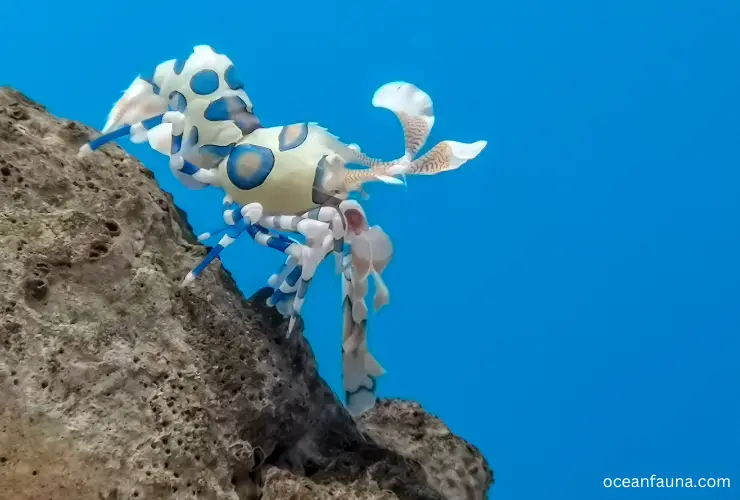
This shrimp has ten legs. The first pair are modified into large, flattened claws called chelipeds that it uses to capture prey and bring food to its mouth. Its eyes are located on stalks protruding from its head, giving it a wide field of view to spot predators and prey.
The Harlequin Shrimp’s first pair of antennae resemble a flattened leaf. These specialized antennae help the shrimp sense the smell of nearby prey. When it detects prey, the shrimp swiftly attacks using its large chelipeds and feeds on various species of starfish found in coral reefs.
Anatomy of Harlequin Shrimp
Exoskeleton
The harlequin shrimp has a hard exoskeleton that provides structure and protection. Its exoskeleton is colorful and patterned, giving the shrimp its distinctive appearance. The exoskeleton must be shed as the shrimp grows through a process called molting.
Digestive system
The harlequin shrimp has a typical crustacean digestive system. It uses its mandibles and maxillae to grind food, which then moves to the esophagus and into the stomach. The stomach uses gastric juices to break down food, which then moves to the intestine to absorb nutrients. Solid waste is excreted through the anus.
Circulatory system
The harlequin shrimp has an open circulatory system with a heart that pumps the body’s hemolymph (crustacean blood). The hemolymph delivers nutrients and oxygen to tissues and removes waste. Since it’s an open system, the hemolymph directly surrounds the organs inside the body.
Nervous system
The harlequin shrimp has a decentralized nervous system with clusters of nerve cells throughout its body. It has sensory organs on its antennae, legs, and tail that detect stimuli like touch, smell, and taste and send signals to the nervous system. The nervous system coordinates the shrimp’s responses and behaviors.
Respiratory system
The harlequin shrimp extracts oxygen from water that flows over its gills, which are located near its legs. Deoxygenated water is expelled from an opening near the shrimp’s tail. The gills have a large surface area to facilitate the exchange of gases.
What Are the Different Types Of Harlequin Shrimp?
There are two distinct types of Harlequin shrimp: Hymenocera picta and Hymenocera elegans. Despite some similarities in their characteristics and appearance, they are often regarded as different species. These mesmerizing creatures possess an unusual body shape that resembles the form of a praying mantis.
Hymenocera picta
Hymenocera picta, the Painted Harlequin Shrimp, is found in the Indo-Pacific region. They are characterized by their vibrant coloration, featuring black and bright yellow or orange bands along their arms and tails. Their size typically ranges between 1.5 and 2 inches, and they have elongated, slender bodies with four walking legs and two sets of arms.
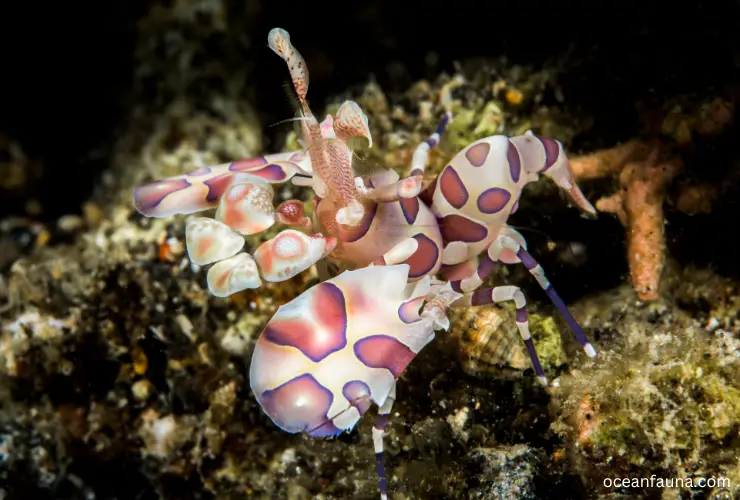
Hymenocera elegans
Hymenocera elegans, commonly known as Elegant Harlequin Shrimp, is found in the western Pacific and Indian Ocean. They have a unique appearance, with their limbs colored in shades of violet or purple and their bodies covered in white spots.
Typically smaller than H. picta, their size ranges from 1 to 1.5 inches. They also have elongated bodies and four walking legs but have only one pair of forelimbs that they use for hunting their prey.
What Do Harlequin Shrimp Eat?
Harlequin shrimp is a picky eater. They have a surprisingly unique diet that consists mainly comprised of echinoderms, particularly starfish. They will also eat a few species of sea urchins, but starfish make up the bulk of their diet. Even the potent toxins found in many starfish do not affect the harlequin shrimp.
To eat a starfish, the harlequin shrimp will flip the starfish onto its back, which disables it. The shrimp then begins eating at the tip of one of the starfish’s arms. It eats its way down the arm all the way to the central disk of the starfish.
The harlequin shrimp uses its claws to peel away the starfish’s spiny exoskeleton to get to the nutrient-rich internal tissues underneath. This peeling behavior and its striking coloration are how the harlequin shrimp got its name – it looks like it is wearing a harlequin costume while eating.
Due to their specialized diet, harlequin shrimp can only be found in areas with abundant starfish populations. They use their powerful claws to capture and subdue starfish, and their digestive systems have evolved to handle the toxins.
The harlequin shrimp’s unique and highly specific feeding behavior makes it an important part of coral reef ecosystems by controlling starfish populations.
Where Do Harlequin Shrimp Live?
Harlequin shrimp is a species of saltwater crustaceans that are native to coral reefs in Hawai’i and the Indo-Pacific region. They live well below the intertidal zone on coral reefs and are known to be relatively rare in their natural habitat.
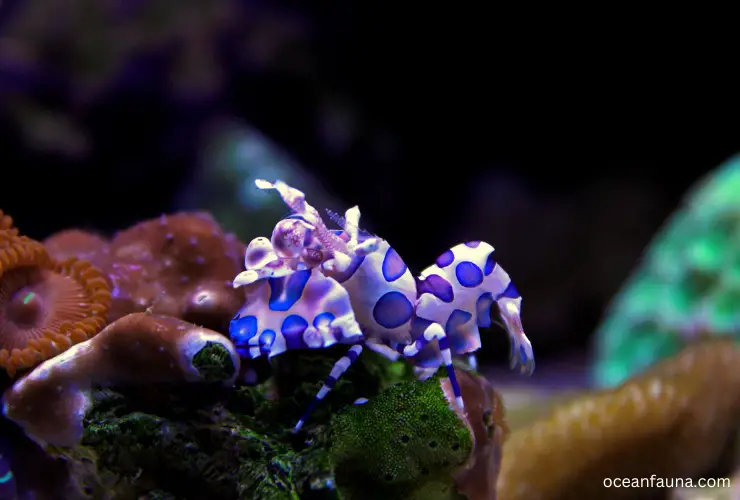
These shrimp are generally found in depths between 1 and 30 meters, where they live in and around coral reefs. They are commonly found in areas with high coral cover and prefer to reside in nooks and crannies of the reef, where they can hide from predators and hunt for food.
Harlequin shrimp have a relatively limited distribution range, occupying the Indo-Pacific region and Hawai’i coral reefs. The suitable temperature for these shrimp is between 72 to 82 °F, which is essential for their survival.
Can Harlequin Shrimp be Kept in Aquarium?
Yes, harlequin shrimp can indeed be kept in an aquarium. However, they require specific care and attention due to their selective diet and other needs.
One of the most important considerations when keeping harlequin shrimp is the size of the Aquarium. While they don’t grow very large themselves, it’s still recommended that the tank be at least 10 gallons or more to ensure stability.
Larger aquariums are typically easier to maintain in the long run, as they can support a more diverse range of life and better handle water parameter fluctuations.
Another important factor to consider is the shrimp’s diet. Harlequin shrimp are known for their selective feeding habits, as they typically only eat starfish – specifically, the arms of the common sea star. Because of this, ensure that there are enough starfish in the Aquarium to sustain these shrimp.
It’s also recommended that the starfish be fed a varied diet to ensure optimal nutrition for the harlequin shrimp.
Regarding water parameters, harlequin shrimp do well in a community or reef tank setting. They aren’t too picky regarding their surroundings, but it’s important to maintain stable water parameters and provide proper filtration and circulation in the tank. Regular water changes and testing can help ensure a healthy environment for these shrimp.
Are Harlequin Shrimps Toxic or Poisonous?
Harlequin shrimps are not toxic or poisonous by themselves. These crustaceans have adapted to feed on starfish, which release a poisonous toxin that repels many predators. Harlequin shrimps have developed immunity to this toxin, and some theories suggest that they even absorb it.
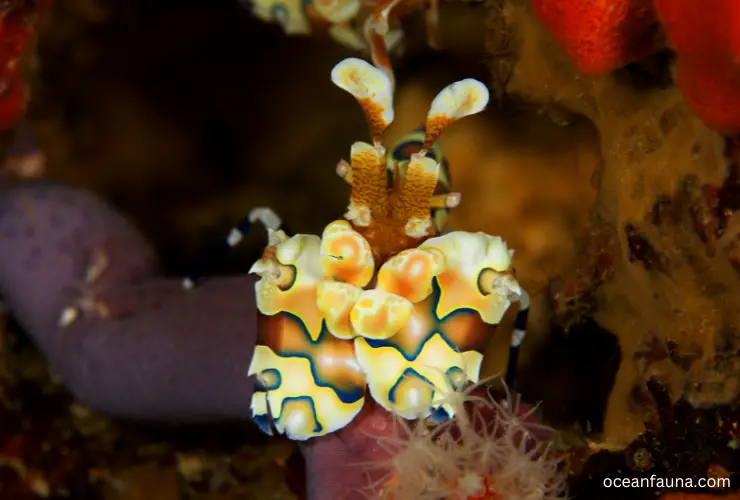
Despite being immune to the starfish toxin, Harlequin shrimps use it as a defense mechanism. Similar to how aquatic insects repel predators, these shrimp use the toxin to ward off potential threats. Therefore, while Harlequin shrimps are not toxic or poisonous, they possess some defense mechanisms through their adaptation to the starfish toxin.
How Long Do Harlequin Shrimps Live?
Harlequin shrimp can live a full 7-year lifespan. However, this assumes they remain undisturbed and can mate and live as a paired male and females. Disturbances such as changes in water parameters or the introduction of predators can significantly reduce their lifespan.
Interestingly, the female harlequin shrimp grows to be just about 2 inches (5 cm) long, while her male counterpart is even smaller. This size difference is common in many shrimp species and is likely due to the male’s reduced requirement for body mass to produce sperm.
How Do Harlequin Shrimp Reproduce?
Harlequin shrimp reproduce sexually. Female harlequin shrimp reach maturity between 200 to 240 days old and typically spawn after each molt, occurring every 18 to 26 days. After fertilization, which happens internally, they transfer the eggs to their abdomens.
Harlequin shrimp are known to be quite fertile and can produce up to 5,000 eggs per season, but on average, they lay between 100 and 1,000 eggs. This process is facilitated by monogamous pairs who establish territorial boundaries to protect their offspring.
The female harlequin shrimp tends to clean the eggs until they hatch. The hatching process usually takes several weeks, but once the eggs hatch, the baby harlequin shrimp are born and can begin their life cycle anew.
Are Harlequin Shrimp Edible?
No, harlequin shrimp are not edible due to their unique defense mechanism. When harlequin shrimp consume toxic starfish, their bodies absorb the toxins and convert them into poisonous substances. This toxin then accumulates in their bodies, making them dangerous for human consumption.
In addition to being toxic, harlequin shrimp are also a typically small species of shrimp. As such, they are not generally considered as a food source. They are often appreciated for their unique coloring and patterns, making them popular in aquariums.
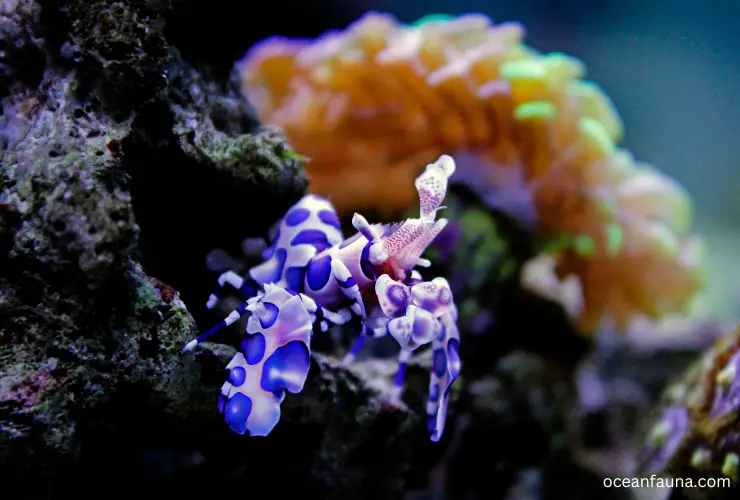
Remember, harlequin shrimp are a part of the sea life ecosystem and play an important role in keeping starfish populations in check. Removing them from the ecosystem would have negative consequences and disrupt the delicate balance of the ocean food chain.
Are Harlequin Shrimp Rare?
Harlequin shrimps are considered relatively rare on any reef. This is due to their specific habitat requirements to thrive, such as the presence of certain types of sponges or sea stars, which make up their main food source.
Moreover, harlequin shrimps have a limited range of distribution which puts them at a greater risk of overcollection by the aquarium trade or habitat loss due to human activities.
Harlequin shrimps, which are rare, are not currently listed under the International Union for Conservation of Nature (IUCN) Red List category.
[The IUCN Red List is a widely recognized global database that provides a comprehensive inventory of the conservation status of plant, animal, and fungi species. It is a critical tool in assessing species’ vulnerability to extinction and identifying priority areas for conservation actions.]
The absence of harlequin shrimps from the IUCN Red List category does not necessarily mean that they are not threatened or at risk of decline. However, it highlights the need for more research and monitoring to determine their true status and inform conservation efforts.
Conclusion
That’s all about the Harlequin shrimp. I know there are still queries about this oceanic creature. If you want to know more, let me know.

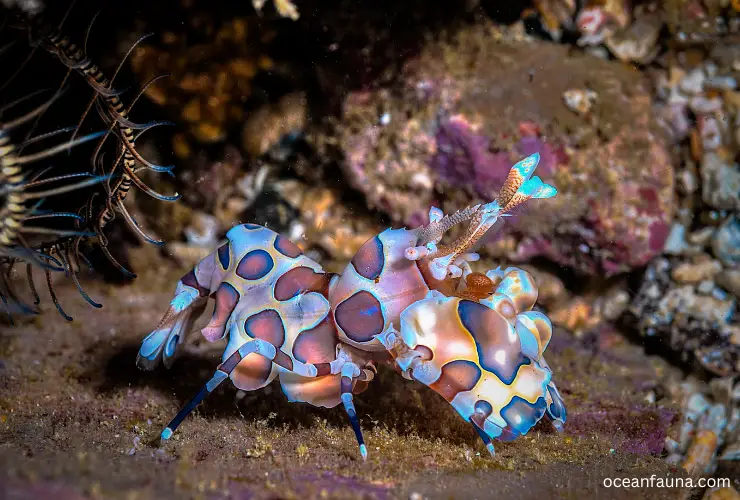
1 thought on “Harlequin Shrimp: Habitat, Diet, Anatomy & Facts”